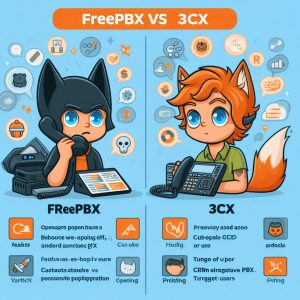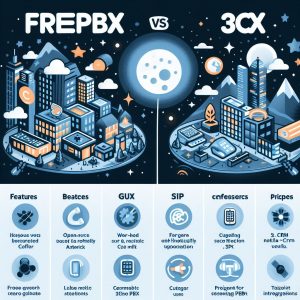Selecting the right IP PBX (Internet Protocol Private Branch Exchange) solution is crucial for businesses seeking to leverage the benefits of VoIP technology. Two of the most popular open-source options are FreePBX and 3CX. While both offer core IP PBX capabilities, there are some important differences in features and approach. Read on for an in-depth comparison of FreePBX vs 3CX to inform your VoIP platform decision.
Overview of FreePBX
FreePBX is an open source GUI (graphical user interface) that manages and provides additional features on top of the powerful Asterisk IP PBX software. Originally created by Schmooze Com Inc, FreePBX is now owned and maintained by Sangoma Technologies.
FreePBX streamlines configuring the advanced but somewhat complex Asterisk engine through an intuitive web-based interface. It enables setting up and controlling essential IP PBX functions like call routing, IVR menus, voicemail, recording, conferencing, call queuing, and reporting without needing to edit configuration files manually.
FreePBX is available free of charge, with paid commercial modules and support options available. It runs on Linux, and supports a wide range of SIP phones and VoIP providers.

Overview of 3CX
3CX is a stand-alone, proprietary IP PBX developed specifically for Windows by 3CX Ltd. It incorporates the SIP standard and interoperates with most SIP phones, VoIP providers, and PSTN networks.
3CX includes a full suite of unified communications features out of the box, including video conferencing, web meeting, softphones, smartphone clients, CRM integrations, live chat, and presence management.
The solution is designed for user-friendliness and ease of management, with an intuitive web-based console and automated setup wizard. Entry-level editions aimed at SMBs are free, with paid licenses expanding capacity and features.
Feature Comparison
Both platforms provide the core capabilities expected from a modern IP PBX. Here’s a more detailed breakdown comparing the built-in features of FreePBX and 3CX:
- Auto-attendants – Advanced IVR and auto-attendant options available on both platforms. 3CX may be easier for quickly setting up menus.
- Extensions – FreePBX supports essentially unlimited extensions. 3CX limits extensions based on licensing tiers.
- Voicemail – Full voicemail management on both. 3CX may be more user-friendly.
- Call Reporting – Robust call reporting included. 3CX reporting may provide more polish and details.
- Conferencing – Ad-hoc conferencing supported on both. 3CX also includes scheduled web conferencing.
- Queueing – Sophisticated queueing and callback options provided by both platforms.
- Integration – FreePBX integrates with popular CRMs. 3CX includes native CRM and live chat.
- Mobility – iOS and Android apps available. 3CX apps provide fuller UC capabilities.
- Admin Interface – FreePBX offers a more open-ended configuration approach compared to 3CX’s wizard-driven process.
For most core features, FreePBX and 3CX are comparable. 3CX aims for maximum simplicity and incorporates more baked-in UC collaboration tools. FreePBX offers more customization and control for experienced users.

Pros and Cons of FreePBX and 3CX
FreePBX
Pros
- 100% free open source platform
- Supports wide array of VoIP phones and trunks
- Active open source community for support and development
- Highly customizable and configurable from admin GUI
- Scalable to very large deployments
Cons
- Steeper learning curve for initial setup and configuration
- Requires managing Linux host server environment
- Limited native mobile and UC capabilities
- Requires paid modules for full features
- Limited official technical support options
3CX
Pros
- Excellent user-friendly admin interface and setup wizard
- Full UC suite built-in for video, collaboration
- iOS and Android clients included
- CRM integration for full productivity
- Scales from free SMB version to large enterprises
- Responsive customer support and training resources
Cons
- Must pay license fees for extended capacity and features
- Proprietary system limits ability to customize/integrate
- Requires Windows server environment
- Number of maximum extensions limited by licensing
- Lacks large open source community support
Real-World Use Cases
How do these differences play out in real-world deployments? Here are sample use cases where FreePBX and 3CX excel:
FreePBX
- Home labs – Freely test and experiment with VoIP capabilities
- VoIP developers – Customize and extend open source platform
- Large enterprises – Scale to support thousands of extensions
- Hybrid integrations – Tie legacy systems into VoIP using Asterisk
3CX
- Small offices – Quickly setup IP phones, IVR, voicemail
- External mobility – Enable remote workers via mobile apps
- Integrated collaboration – Native video conferencing and chat
- Turnkey solution – Get full VoIP system up and running with minimal effort
The ideal option comes down to the environment, use case, and administrator’s expertise.

Conclusion
When evaluating FreePBX vs 3CX, key considerations include your budget, server platform, VoIP experience, and need for built-in UC tools. Both provide enterprise-grade IP PBX functionality, but 3CX emphasizes turnkey experience while FreePBX offers greater customization and community support. Define your must-have features, then choose the platform that best aligns with your technical environment, resources, and use cases. With both solutions, businesses can cost-effectively transition to advanced VoIP communications and unlock productivity.